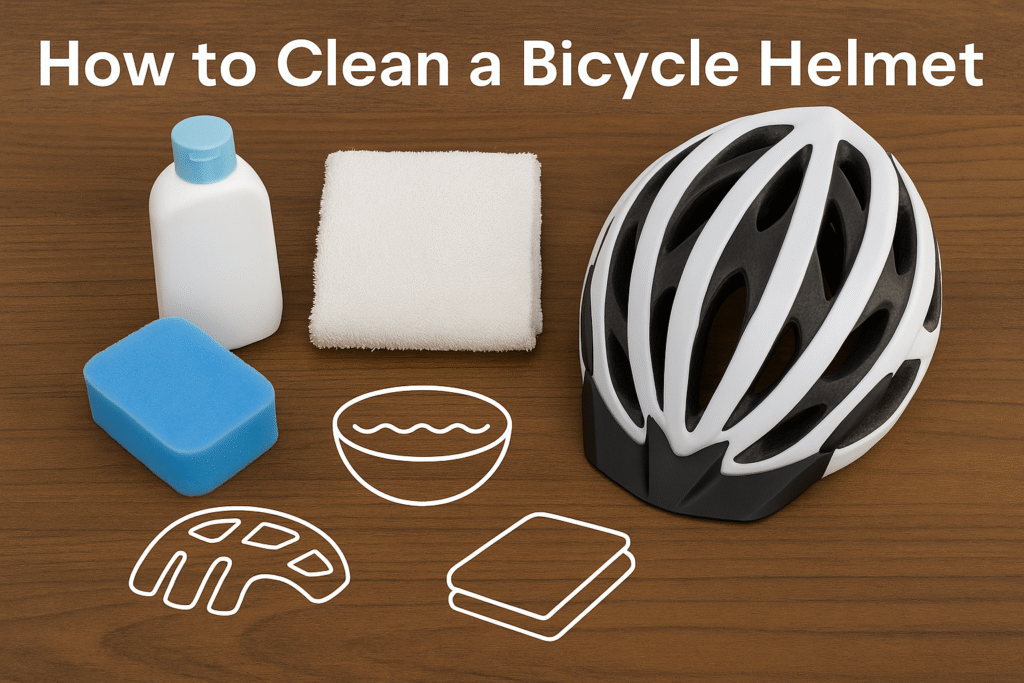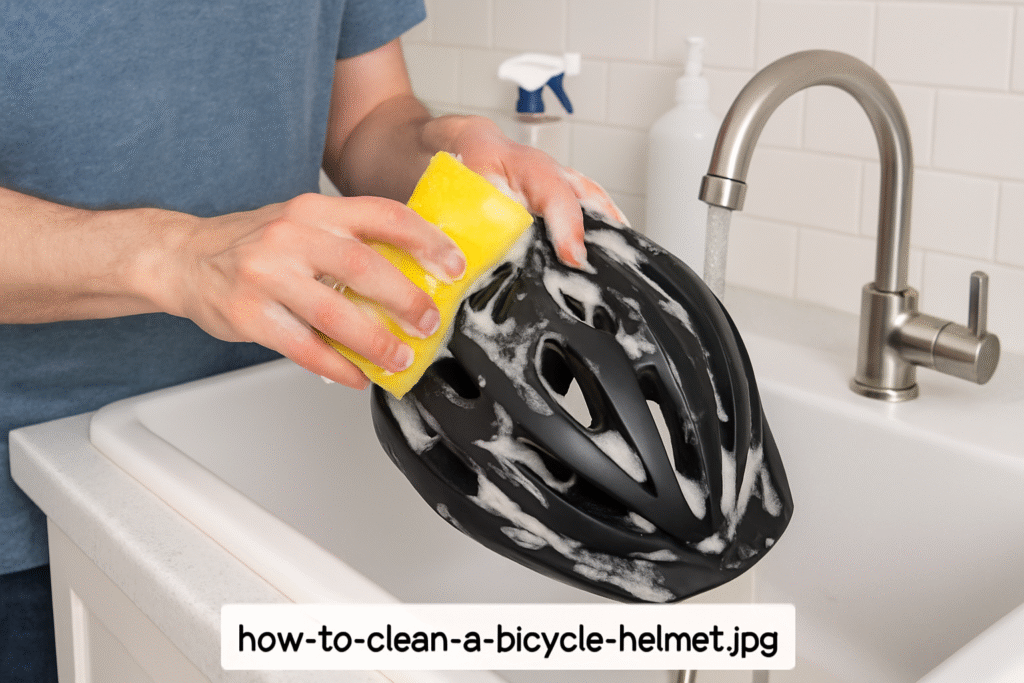1. Introduction
Learning how to clean a bicycle helmet is essential for every rider who values safety, comfort, and hygiene. Whether you’re wearing a dirt bike helmet with speakers, a Bluetooth dirt bike helmet, or the best bike helmet for women’s hair, regular cleaning helps maintain both performance and appearance.
Over time, sweat, dirt, and grime can build up in the padding, straps, and vents, leading to odor and wear if not properly handled. In this guide, we’ll cover simple, effective steps to keep your helmet fresh and well-maintained, with extra care tips for tech-integrated and women’s helmets.
Table of Contents

2. Why You Should Clean Your Bicycle Helmet Regularly
- A clean bicycle helmet helps maintain hygiene by removing sweat, dirt, and bacteria that can accumulate after regular use.
- Cleaning your helmet regularly prevents unpleasant odors caused by trapped moisture and bacteria in the inner padding and straps.
- Dirt and grime buildup can degrade the materials of your helmet over time, shortening its lifespan and reducing its effectiveness in protecting your head.
- Regular cleaning ensures better airflow through the helmet vents, improving ventilation during rides.
- Sweat and hair products can stain or damage the inner foam and lining, especially in helmets designed for long hair, such as the best bike helmet for women’s hair.
- Keeping your helmet clean maintains the visibility of reflective elements and enhances your safety during low-light rides.
- Riders using advanced gear like a Bluetooth dirt bike helmet should clean it regularly to protect sensitive electronics from sweat and dust.
- Following proper helmet care aligns with recommendations from top dirt bike helmet brands, ensuring your gear remains reliable and safe.
3. Supplies You’ll Need Before You Start
- Mild, non-abrasive soap or helmet-safe detergent to clean both the outer shell and inner padding without damaging materials.
- A soft cloth or sponge for gently wiping down the helmet surface, especially useful for cleaning a dirt bike helmet.
- A small toothbrush or detailing brush to reach tight areas like ventilation holes, buckle crevices, and speaker slots in a Bluetooth dirt bike helmet.
- Lukewarm water in a bowl or basin to rinse off dirt and soap residue safely.
- Microfiber towel for drying the helmet without scratching the shell or inner lining.
- Optional disinfectant spray that’s safe for foam and fabric, ideal for helmets used frequently or in hot climates.
- A clean, shaded area for air-drying to avoid direct sunlight that could damage the foam or fade the finish, especially in high-end dirt bike helmet brands.
- For helmets with built-in electronics like a dirt bike helmet with speakers, have a dry cloth ready to carefully wipe tech components after removing them.
4. Step-by-Step Guide: How to Clean a Bicycle Helmet

a. Remove the Inner Padding
- Carefully detach the helmet’s inner padding to prevent tearing or damage.
- Padding collects sweat, dirt, and bacteria, especially in high-use helmets like dirt bike helmets.
- Removing padding allows for a more thorough and hygienic cleaning process.
b. Clean the Shell
- Use a soft cloth or sponge with mild soap and lukewarm water to gently clean the helmet shell.
- Avoid using harsh chemicals that can degrade the helmet’s protective outer layer.
- Wipe down vents and edges thoroughly, especially if cleaning a Bluetooth dirt bike helmet or a helmet with advanced features.
c. Wash the Padding
- Hand-wash the padding using mild detergent in warm water to preserve the foam structure.
- Rinse well to remove all soap residue and eliminate odors caused by sweat and hair products.
- This step is important for maintaining hygiene in helmets like the best bike helmet for women’s hair.
d. Straps and Buckles
- Scrub the straps gently with a toothbrush and soapy water to remove sweat and dirt buildup.
- Clean the buckle area carefully to ensure it functions properly and isn’t clogged with debris.
- If your helmet is a dirt bike helmet with speakers, ensure no water reaches the tech components.
e. Drying Tips
- Air dry all parts of the helmet in a shaded, ventilated area to avoid foam damage from direct sunlight.
- Do not use a hairdryer or dryer, as high heat can warp padding and weaken adhesives.
- Reassemble the helmet only after all parts are completely dry to prevent mildew and odor buildup.
5. Extra Care for Dirt Bike Helmets and Tech-Integrated Helmets
- Remove all electronic components such as speakers or Bluetooth modules before cleaning a Bluetooth dirt bike helmet.
- Use a dry or slightly damp cloth to gently wipe the surface of any tech-integrated areas, avoiding moisture near connection points.
- Clean the exterior shell of dirt bike helmets with a soft sponge and helmet-safe soap to remove mud, dust, and debris without damaging the finish.
- Use a toothbrush to clean around vents and ridges where dirt often collects on dirt bike helmet brands with aggressive shell designs.
- Avoid soaking any part of a tech-integrated helmet to prevent internal water damage.
- Allow the helmet to dry naturally in a shaded area before reinstalling electronics or padding.
- Regular maintenance helps extend the life of helmets with built-in features like a dirt bike helmet with speakers while ensuring safety and performance.
- Refer to care guidelines provided by specific dirt bike helmet brands to ensure proper handling of brand-specific materials and technologies.
6. Helmet Cleaning Tips for Women
- Use a mild detergent to clean the padding, especially if you use hair products that can transfer to the liner.
- Wash inner pads regularly to maintain hygiene and reduce scalp irritation caused by sweat and residue buildup.
- Let the padding air dry completely before reinstalling to prevent moisture from damaging the inner foam.
- Choose helmet liners that are removable and washable for easier maintenance, especially when using the best bike helmet for women’s hair.
- Wipe the shell with a soft cloth to remove makeup or sunscreen stains that may affect the helmet’s finish.
- Wear a lightweight headband or cycling cap to absorb sweat before it reaches the helmet padding, helping to extend the time between cleanings.
- Avoid using scented sprays or fabric softeners on helmet padding, as they may irritate the skin or scalp.
- Keep your helmet in a shaded, well-ventilated area to prevent heat damage and maintain the integrity of both the outer shell and inner padding.
7. Pro Tips from Top Dirt Bike Helmet Brands
- Always follow the manufacturer’s cleaning instructions to avoid damaging materials used in premium dirt bike helmet brands like Fox, Bell, or Shoei.
- Use only mild soap and water when cleaning to protect the paint, finish, and structural integrity of the helmet shell.
- Remove all interior components before washing, especially in a Bluetooth dirt bike helmet, to protect electronic parts.
- Allow each part—shell, padding, and straps—to dry separately in a well-ventilated area, away from direct sunlight.
- Replace interior liners or cheek pads if they show signs of wear, as suggested by most high-end dirt bike helmet brands.
- Inspect vents and visors for dirt buildup after each ride, especially if you’re using a dirt bike helmet with speakers or other built-in features.
- Regular cleaning improves airflow and visibility, enhancing performance and comfort during long or off-road rides.
- Place your helmet in a ventilated storage bag to shield it from dirt, surface damage, and fluctuations in temperature.
8. Common Mistakes to Avoid When Cleaning Your Helmet
- Using harsh chemicals or abrasive cleaners can degrade the helmet’s outer shell and compromise its protective features.
- Submerging a Bluetooth dirt bike helmet in water may damage built-in electronics or non-removable components.
- Cleaning with hot water or exposing the helmet to high heat can warp the inner foam and reduce impact protection.
- Failing to fully dry your helmet or putting it away while still damp can cause musty smells and encourage mold to develop inside the padding.
- Machine-washing the inner padding without checking the manufacturer’s care instructions may cause shrinkage or tearing.
- Using scented sprays or strong detergents on padding can cause skin irritation and degrade helmet materials.
- Forgetting to remove electronic accessories before cleaning a dirt bike helmet with speakers can lead to irreversible damage.
- Exposing your helmet to direct sunlight while drying can discolor the exterior and break down the adhesives holding the inner materials in place.
9. Conclusion
Keeping your helmet clean isn’t just about looks—it’s a key part of staying safe, comfortable, and healthy on every ride. Whether you’re using a standard road bike helmet or a tech-loaded Bluetooth dirt bike helmet, regular maintenance helps extend its life and ensures it performs at its best. By learning how to clean a bicycle helmet the right way, you protect your gear from sweat, bacteria, and wear while maintaining comfort and hygiene.
Paying attention to padding, straps, and even helmet electronics not only improves your riding experience but also aligns with care practices recommended by top dirt bike helmet brands. And if you’re wearing the best bike helmet for women’s hair, a clean, fresh liner can make all the difference in both fit and feel. Stick to a gentle, consistent cleaning routine—and your helmet will continue to protect you ride after ride.
10. FAQs
Q1: How often should I clean my bicycle helmet?
You should clean your helmet at least once a month, or more frequently if you ride in hot, sweaty conditions or on dusty trails. Regular cleaning keeps it fresh and extends its lifespan.
Q2: Is it okay to clean helmet padding in the washing machine?
Some padding is machine washable, but it’s safest to hand-wash with mild soap and warm water. Always check your helmet brand’s care instructions to avoid damaging the materials.
Q3: Is it safe to use disinfectant spray inside the helmet?
Yes, as long as it’s a fabric-safe, non-toxic spray. Avoid sprays with strong chemicals that can irritate your skin or degrade foam and padding.
Q4: How do I clean a Bluetooth dirt bike helmet?
Remove any electronic components first. Clean the shell and padding gently with a damp cloth and mild soap, keeping water away from speaker ports and wiring areas.
Q5: Can sunlight damage my helmet during drying?
Yes. Drying your helmet in direct sunlight can fade the outer shell and weaken adhesives inside. It’s best to let it air dry in a shaded, well-ventilated spot.
Q6: How can I effectively keep my helmet from developing unpleasant odors?
Regular cleaning, using a sweatband or cycling cap, and letting your helmet dry fully after each ride can help prevent unpleasant smells from building up.
Q7: Do women’s helmets need special care?
Not necessarily, but if you’re using the best bike helmet for women’s hair, it’s a good idea to clean it more often, especially if you use hair products that can transfer to the padding.
